If you are unsure whether an injection is right for you, we are happy to organise a complimentary phone call with one of our clinicians – Click here to book now
What is a tennis elbow (also known as common extensor tendinopathy or lateral epicondylitis)?
Tennis elbow is a common condition which causes pain on the outside of the elbow. It is often caused by repetitive use of the forearm (extensor) muscles. It effects men and women of all ages. It is more prevalent in those that play racket sports such as tennis, squash and golf, but also in individuals that lift weights in the gym and manual workers such as carpenters and plasterers.
Tennis elbow can be a frustrating and debilitating condition especially if it effects your ability to play sport or go to work. In a majority of tennis elbow cases it responds positively to a combination of physiotherapy and activity modification. For those cases that do not respond, an ultrasound guided steroid injection or a course of platelet rich plasma (PRP) injections can significantly improve your pain and get you back to full function.
What are the symptoms of tennis elbow?
The symptoms of a tennis elbow are:
- Pain, point tenderness and occasional swelling on the bone and muscles on the outside of the elbow
- Pain that is made worse by lifting e.g., lifting a weight or kettle or carrying shopping, and/or twisting movements, such as opening a jar or turning a door handle
- Extreme pain if you hit the outside of your arm against a wall or door
If this sounds like your pain, read on…
What other conditions can mimic tennis elbow?
If this does not sound like your pain there are other conditions that can mimic the pain of tennis elbow such as:
- Golfer’s elbow
- Posterior Interosseus Nerve (PIN) entrapment
- Distal biceps tendon
Tennis elbow vs golfer’s elbow
Tennis elbow causes pain and tenderness on the outside of the arm, whereas golfers elbow causes pain and tenderness on the inside of the elbow. Both tennis elbow pain and golfers elbow pain are aggravated by lifting weight and gripping.
The anatomy
Tennis elbow occurs when the muscles that extend your wrist are overused, misused or abused, for example when revving up a motorbike, gripping a tennis racquet or picking up a dumbbell in the gym. This causes the tendinous insertion of the muscles to become irritated. Tendon irritation is often known as tendinitis or tendinopathy. Over time repeated bouts of tendon irritation causes the tendon to become thickened and worn. This process is known as tennis elbow or lateral epicondylitis.

How do you know if you have tennis elbow?
Tennis elbow is the most common injury to occur at the elbow. It is described as a sharp, burning ache located on the outside corner of the elbow. Symptoms present themselves gradually, without trauma, and are often ignored for many months until they become too much to bear. Many different types of people can suffer from tennis elbow. You do not have to be a tennis player to suffer from tennis elbow! People who repetitively use their wrists and fingers are at risk, such as computer users, builders, gym-goers and racket sports enthusiasts are susceptible.
Symptoms typically remain local to the outside corner of the elbow and include;
- Pain with gripping, lifting and carrying
- Feelings of weakness with gripping tasks due to pain
- Pain with making a fist
- Pain with opening jars, pouring kettles or turning doorknobs
- Pain with typing
- Pain during repetitive tasks using the fingers and wrist, for example; playing the guitar
What can you do if you have tennis elbow?
The sooner you seek professional help, the easier it is to treat tennis elbow. At Complete, our team of experienced clinicians will be able to accurately diagnose and treat you using the best evidence-based treatment options available. During your assessment, a real-time ultrasound scan will be completed. This helps to confirm the diagnosis but also to check if you have a tear in your tendon. The scan allows for accurate assessment of the severity of the problem and aid in treatment selection. Once a full diagnosis has been made, your clinician will be able to discuss the most effective treatment options with you.

How is tennis elbow treated?
Tennis elbow can be slow to recover and therefore, effective treatment selection is paramount.
Treatment usually starts with conservative modalities such as;
- Physiotherapy
- Forearm rehabilitation exercises
- Acupuncture
- Sports taping
- Advice on activity modification
Here are a few tips you might like to try;
- Wrist stretches and local massage to the forearm muscles (not over the actual pain spot).
- Rest from aggravating activities such as racquet sports. This allows the local inflammatory response to settle.
- Purchase an ‘epiclasp’ (tennis elbow band/support). This may help to reduce tension at the elbow when using your wrist and elbow.
- Try a small bag of frozen peas over the elbow after activities that cause pain. Ten minutes is enough.
- Try using a topical anti-inflammatory such as Voltarol gel, but speak to a pharmacist first
What if conservative treatment doesn’t work?
If conservative options have been unsuccessful, there are a few other treatment modalities available to you. These include:
Extracorporeal Shockwave Therapy (ESWT)
ESWT is an effective, evidence-based treatment option for treating tendon pain. It does this by desensitising irritated nerve endings and by causing controlled micro-trauma, triggering the body’s healing process. All clinicians at Complete are fully qualified to provide ESWT. This can be discussed with your clinician or by contacting us on 02074823875 or email info@complete-physio.co.uk.
Steroid injection
Steriod injections may be required if pain is persistent and nothing else is working. A mixture of local anaesthetic and corticosteroid (a potent anti-inflammatory) is injected under the guidance of a real-time ultrasound scan. This is to ensure the affected area is accurately targeted. Research has shown that guided injections are more accurate and are more effective at reducing pain than non-guided injections.
Hyaluronic Acid injection (Ostenil)
Hyaluronic Acid is a naturally occurring substance within the body. There is a growing body of evidence suggesting its efficacy in treating chronic musculoskeletal pathology. It may be used, with a local anaesthetic, as a safe alternative to steroid.
Platelet-rich plasma (PRP) injections
PRP injections are an evidence-based treatment option for those suffering from chronic tendon issues. Blood is taken via a vein in your arm. It is spun in a centrifuge machine, separating the blood molecules. The plasma is removed and then re-injected into and around the target. Plasma has powerful healing properties allowing the body to regenerate the tendon quickly and effectively. The evidence suggests a series of 3 injections are required to achieve maximum benefit.
Complete has a team of highly experienced physiotherapists and musculoskeletal sonographers. Our team are fully qualified to prescribe medication, scan and carry out ultrasound guided injections. For further information, please contact us on 0207 482 3875 or email injections@complete-physio.co.uk.
Other Elbow Conditions:
If you are unsure whether an injection is right for you, we are happy to organise a complimentary phone call with one of our clinicians – Click here to book now

